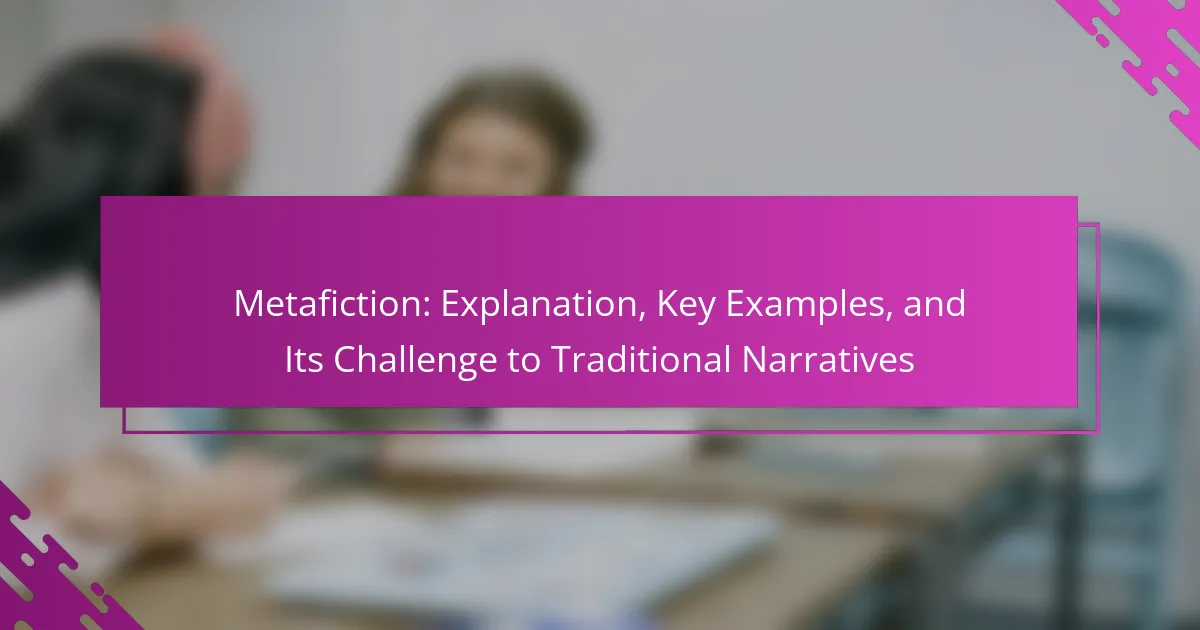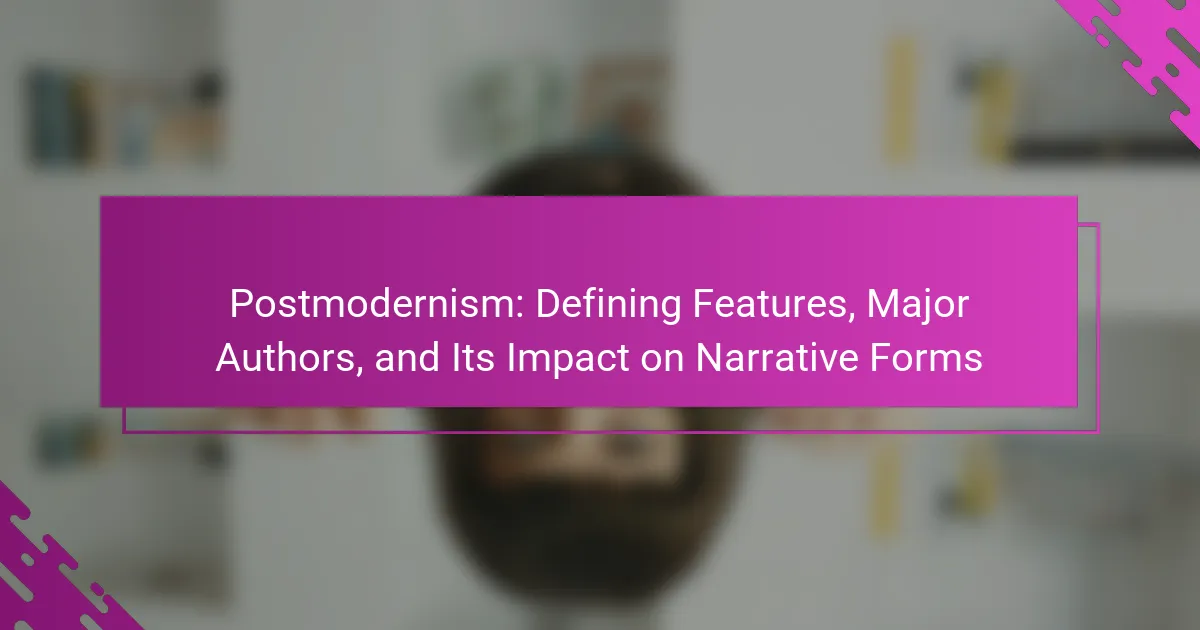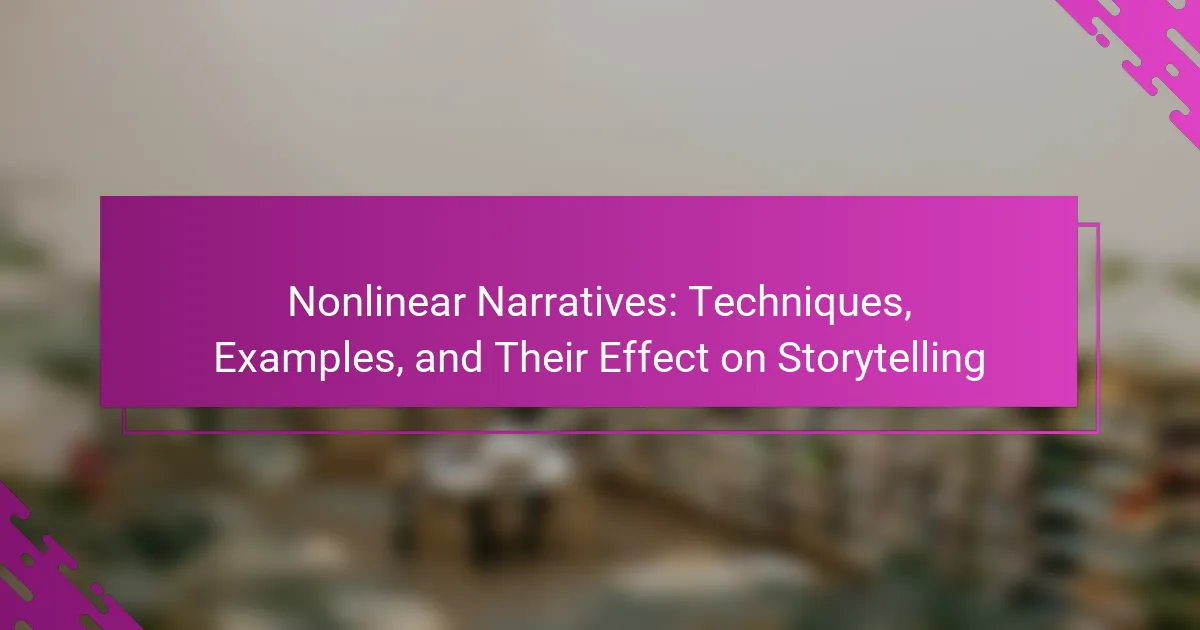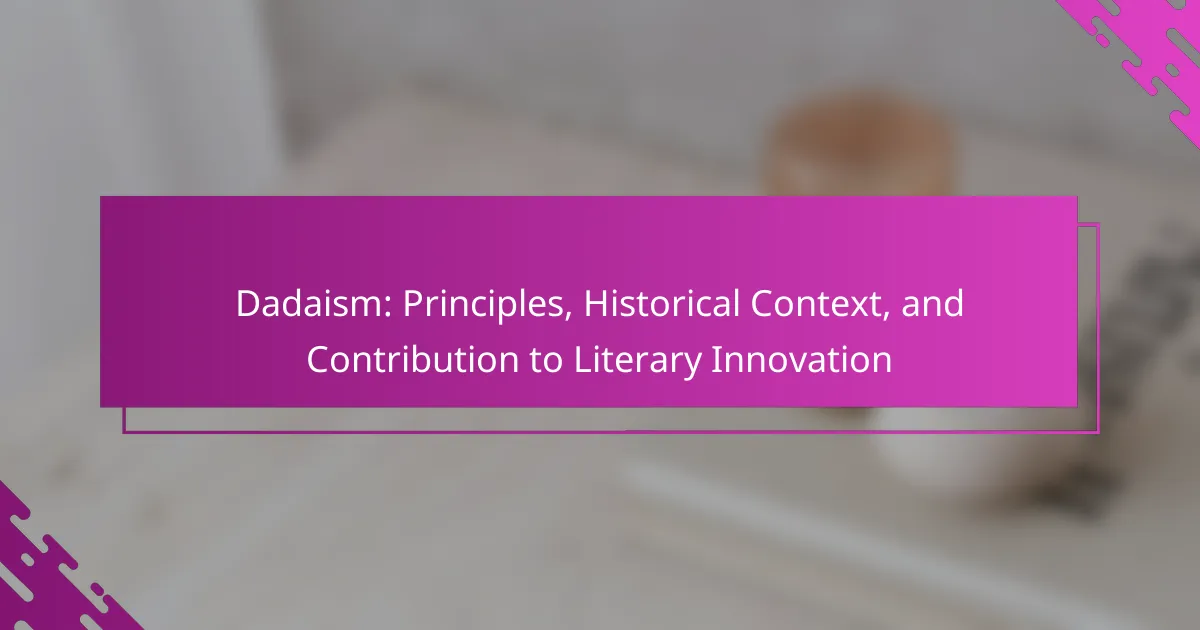Experimental literature challenges conventional storytelling by employing innovative narrative structures and engaging readers in unique ways. Key characteristics include fragmented narratives and non-linear timelines. Notable works like “House of Leaves” and “If on a winter’s night a traveler” exemplify these traits and their influence on contemporary narratives. The genre’s evolution reflects diverse cultural contexts and future trends, including increased interactivity and the integration of digital elements.
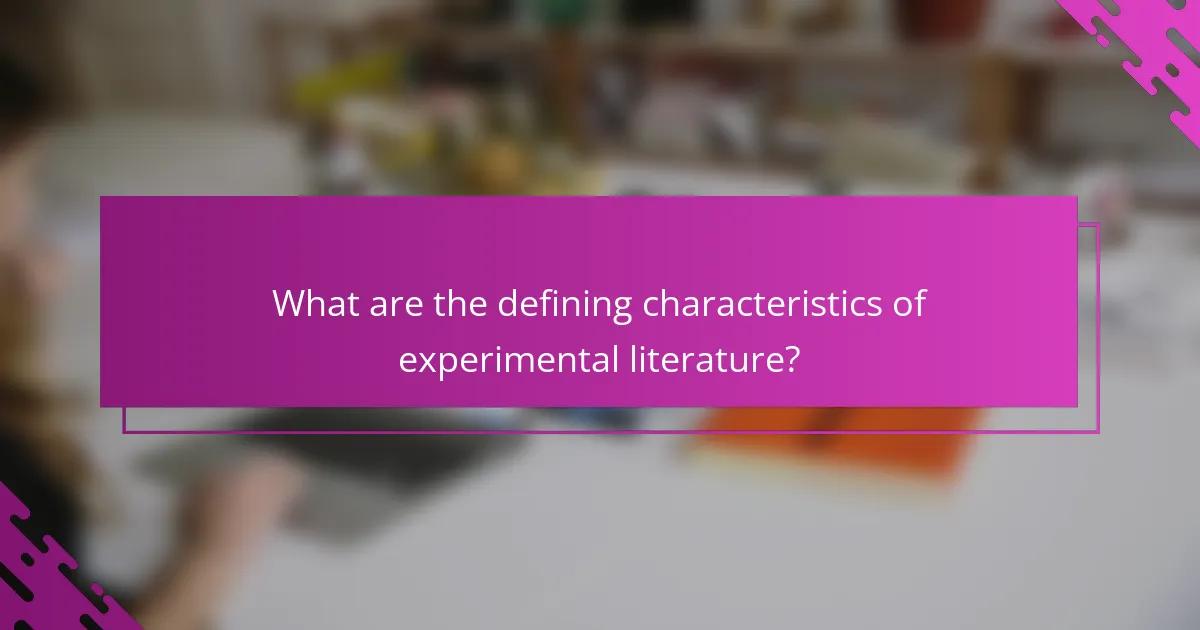
What are the defining characteristics of experimental literature?
Experimental literature is characterized by its unconventional narrative structures, innovative use of language, and exploration of form. It often challenges traditional storytelling techniques and invites reader participation.
Key characteristics include fragmented narratives, non-linear timelines, and metafictional elements that self-reflect on the act of writing. These features create a unique reading experience that emphasizes the art of storytelling itself.
Notable works include “House of Leaves” by Mark Z. Danielewski, which employs unconventional formatting and footnotes, and “If on a winter’s night a traveler” by Italo Calvino, which plays with narrative perspective and reader engagement.
The influence of experimental literature extends into contemporary storytelling, inspiring writers to push boundaries and explore new ways of engaging readers. This evolution reflects a growing appreciation for diverse literary forms and the potential for storytelling to transcend traditional limits.
How does narrative structure differ in experimental works?
Experimental literature often employs non-linear narrative structures, diverging from traditional storytelling. This approach can include fragmented timelines, multiple perspectives, and unconventional formats, creating a unique reading experience. Key works, such as “House of Leaves” by Mark Z. Danielewski, exemplify this by challenging readers’ perceptions of narrative coherence. The influence of experimental literature on storytelling lies in its ability to push boundaries, inviting deeper engagement and interpretation from readers.
What role does language play in experimental literature?
Language is fundamental in experimental literature as it challenges conventional narrative forms and explores new ways of expression. It serves as a tool for authors to manipulate structure, rhythm, and meaning, creating unique reading experiences. By employing unconventional syntax, fragmented narratives, and innovative wordplay, authors can evoke emotions and provoke thought. Experimental literature often pushes boundaries, inviting readers to engage actively with the text. This engagement fosters a deeper understanding of language’s role in shaping perception and experience. Key works exemplifying this include “House of Leaves” by Mark Z. Danielewski and “If on a winter’s night a traveler” by Italo Calvino, both showcasing the transformative power of language in storytelling.
Which themes are commonly explored in experimental literature?
Experimental literature commonly explores themes of identity, reality, perception, and the nature of storytelling. These themes challenge conventional narrative structures, inviting readers to engage in a deeper exploration of meaning. Works often blur the lines between fiction and reality, reflecting the complexities of human experience. Additionally, themes of fragmentation and non-linear narratives frequently appear, emphasizing the subjective nature of truth and memory.
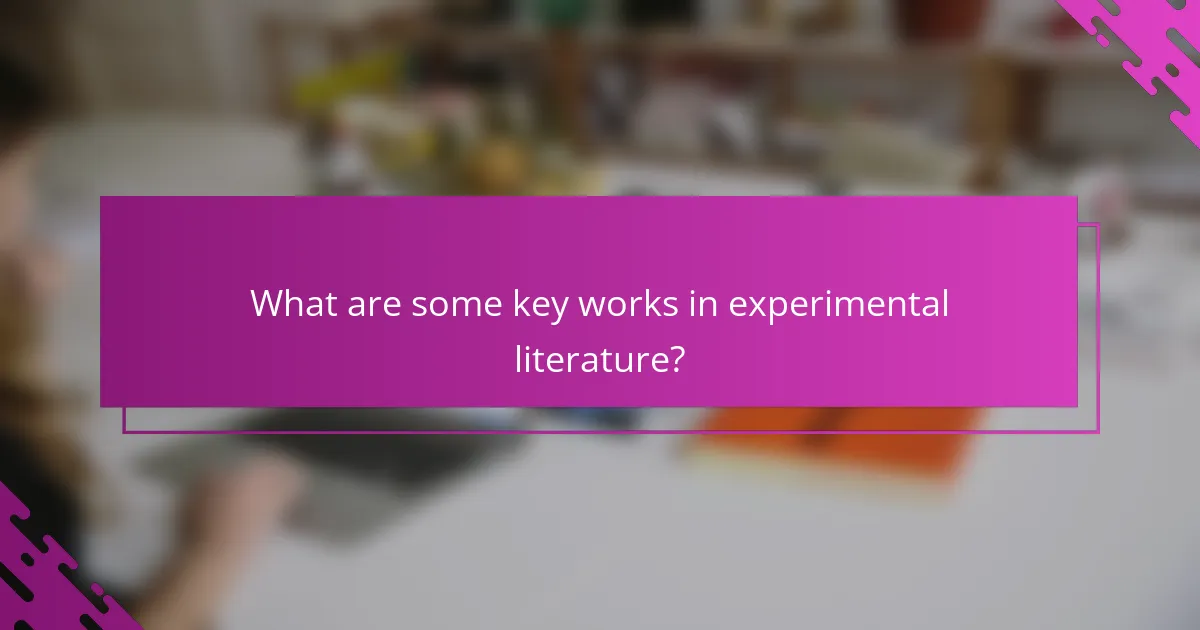
What are some key works in experimental literature?
Key works in experimental literature include “House of Leaves” by Mark Z. Danielewski, “If on a winter’s night a traveler” by Italo Calvino, and “The Unfortunates” by B.S. Johnson. These texts challenge traditional narrative structures, employing unconventional formats and reader engagement techniques. They exemplify the unique attribute of breaking the fourth wall and invite readers to participate actively in the storytelling process. Other notable works are “Naked Lunch” by William S. Burroughs and “A Void” by Georges Perec, which showcase rare attributes like non-linear storytelling and constraints that redefine literary boundaries.
How did James Joyce’s “Ulysses” redefine narrative techniques?
James Joyce’s “Ulysses” redefined narrative techniques through stream of consciousness, nonlinear storytelling, and deep character introspection. These innovations allowed for a more immersive exploration of human thought and experience. Joyce’s work influenced modernist literature by challenging traditional narrative forms and emphasizing subjective perception. His use of everyday language and detailed inner monologues created a new literary style that inspired countless authors and transformed storytelling.
What impact did Virginia Woolf’s “To the Lighthouse” have on character development?
Virginia Woolf’s “To the Lighthouse” significantly advanced character development through its stream-of-consciousness technique. This approach allows readers to experience characters’ inner thoughts and emotions directly, creating a profound connection. Woolf’s focus on subjective experience deepens character complexity, challenging traditional narrative forms. The fluidity of time and perspective in the novel reflects characters’ evolving identities, showcasing their psychological depth. This innovative method influenced modern storytelling, encouraging writers to explore internal landscapes over external actions.
Which contemporary authors are pushing the boundaries of experimental literature?
Contemporary authors pushing the boundaries of experimental literature include Mark Z. Danielewski, Jennifer Egan, and David Mitchell. Their works challenge traditional storytelling through innovative structures and narrative techniques.
Mark Z. Danielewski’s “House of Leaves” employs unconventional formatting and multiple narratives to create a labyrinthine reading experience. Jennifer Egan’s “A Visit from the Goon Squad” features interconnected stories that span different time periods and perspectives. David Mitchell’s “Cloud Atlas” weaves together six distinct narratives across various genres and eras, showcasing the interconnectedness of human experience.
These authors exemplify how experimental literature can redefine storytelling, engaging readers in new and thought-provoking ways.
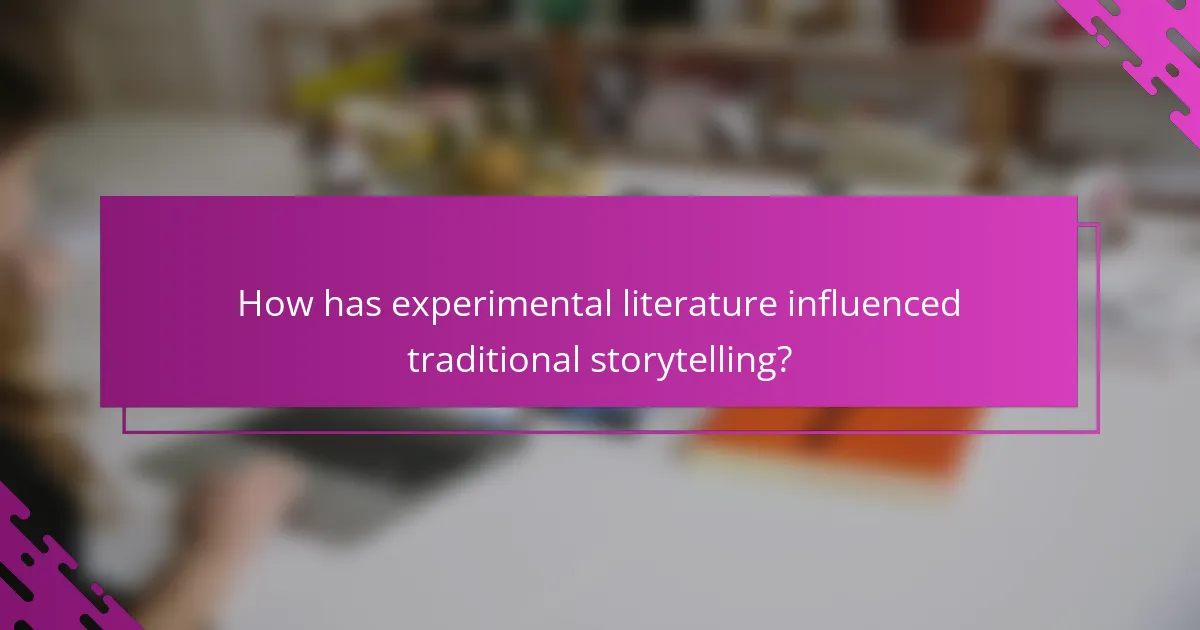
How has experimental literature influenced traditional storytelling?
Experimental literature has profoundly influenced traditional storytelling by challenging narrative structures and expanding thematic boundaries. This genre often incorporates unconventional techniques, such as non-linear timelines and fragmented narratives, which encourage readers to engage actively with the text. Key works, like James Joyce’s “Ulysses” and Virginia Woolf’s “To the Lighthouse,” exemplify these characteristics, showcasing how experimental approaches can deepen emotional resonance and explore complex human experiences. As a result, traditional storytelling has evolved, integrating these innovative elements to create richer, more layered narratives that reflect modern sensibilities.
What techniques have been adopted from experimental literature into mainstream narratives?
Experimental literature has influenced mainstream narratives by introducing non-linear storytelling, fragmented narratives, and unreliable narrators. These techniques enhance reader engagement and challenge traditional storytelling norms. For example, authors like Virginia Woolf and James Joyce employed stream-of-consciousness techniques that have been adopted in contemporary fiction. As a result, modern narratives often explore character psychology and subjective experiences, creating deeper emotional connections. Additionally, the blending of genres and breaking of the fourth wall are now common in mainstream literature, reflecting the experimental roots in storytelling.
How do readers’ perceptions of storytelling change through experimental literature?
Readers’ perceptions of storytelling evolve significantly through experimental literature. This genre challenges traditional narrative structures, fostering new interpretations and emotional responses.
Experimental literature often employs non-linear narratives, fragmented plots, and unconventional formats. These elements encourage readers to engage actively, prompting them to construct meaning rather than passively consuming a story. Key works like “House of Leaves” by Mark Z. Danielewski exemplify this shift, as they require readers to navigate complex layouts and multiple narratives.
As a result, readers may experience heightened awareness of language and form. This can lead to a deeper appreciation of storytelling as an art form, influencing their expectations and preferences for future literary works. The unique attributes of experimental literature push boundaries, reshaping how stories are told and understood.
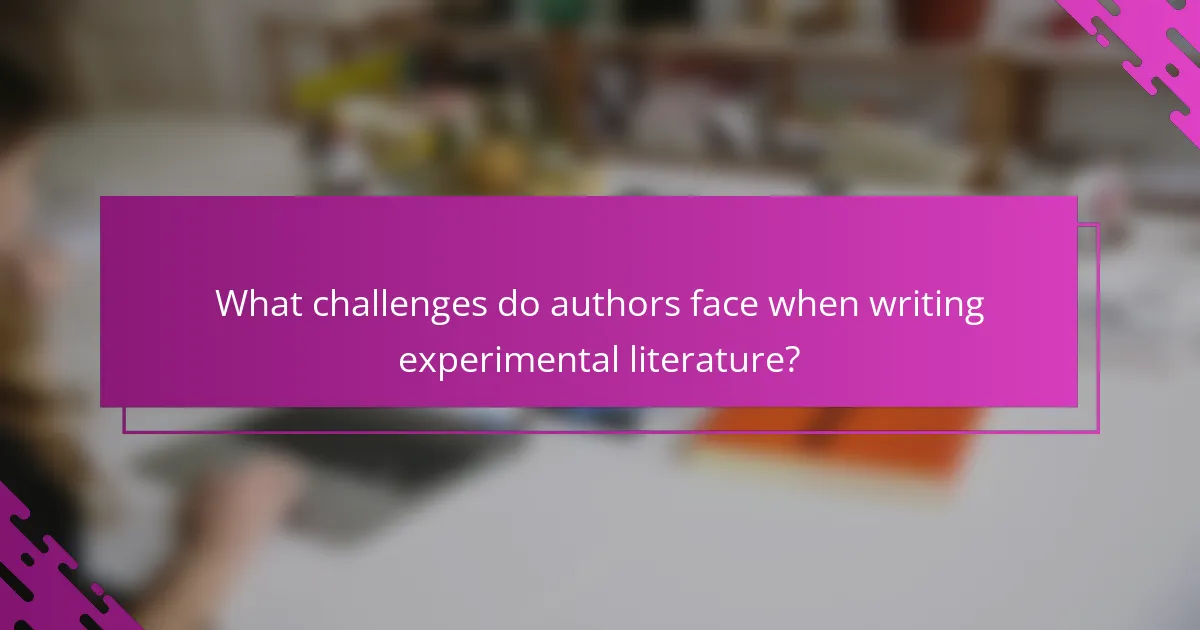
What challenges do authors face when writing experimental literature?
Authors face various challenges when writing experimental literature, primarily due to its unconventional nature. These challenges include difficulty in defining structure, as traditional narrative forms may not apply. Authors often struggle with audience reception, as readers may find experimental works inaccessible or confusing. Additionally, maintaining coherence while exploring innovative styles can be daunting. The risk of alienating readers or receiving criticism for non-conformity further complicates the creative process.
How can experimental literature be received by audiences?
Experimental literature can be received by audiences in diverse ways, often evoking strong emotional responses and challenging traditional narrative forms. Readers may appreciate the innovative structures and themes, leading to a deeper engagement with the text. However, some may find it difficult to relate to or understand the unconventional techniques, resulting in mixed reactions. The unique attributes of experimental literature, such as fragmented narratives and non-linear timelines, can either captivate or alienate audiences. Overall, the reception hinges on individual perspectives and openness to literary experimentation.
What are common misconceptions about experimental literature?
Common misconceptions about experimental literature include the belief that it is inaccessible, overly complex, or lacking in narrative. Many think it is only for avant-garde audiences, while in reality, it often engages with universal themes and emotions. Another misconception is that experimental literature is devoid of structure; however, it frequently employs innovative forms that challenge traditional storytelling. Lastly, some believe that experimental literature lacks coherence, but many works maintain a clear thematic focus despite their unconventional techniques.

How does cultural context shape experimental literature in different regions?
Cultural context significantly influences experimental literature by shaping themes, styles, and reader engagement. In regions with rich oral traditions, literature often incorporates storytelling techniques that reflect local customs. For example, Latin American experimental works frequently blend magical realism with socio-political commentary, highlighting unique cultural narratives. In contrast, Asian experimental literature may focus on collective identity and philosophical introspection, showcasing distinct regional values. This interplay between culture and literature fosters diverse storytelling methods, enriching the global literary landscape.
What influences do regional literary movements have on experimental works?
Regional literary movements significantly shape experimental works by introducing diverse perspectives and innovative techniques. These movements challenge traditional storytelling, fostering unique narrative structures and thematic explorations. For example, the Beat Generation influenced the use of free verse and stream of consciousness, while postmodernism introduced metafiction and intertextuality. Such influences encourage writers to break conventions, resulting in works that reflect cultural and social dynamics. The interplay of regional characteristics and experimental forms enriches the literary landscape, pushing boundaries and expanding the definition of literature.
How do societal issues manifest in experimental literature across cultures?
Societal issues manifest in experimental literature through innovative narrative techniques and thematic explorations. Authors often challenge traditional storytelling by incorporating fragmented structures, non-linear timelines, and diverse perspectives. This approach allows for a deeper examination of cultural contexts, identity, and social justice.
Experimental literature reflects societal issues by using unique attributes like stream-of-consciousness writing and metafiction. These techniques enable authors to represent complex realities and highlight marginalized voices. For instance, works like “The Sound and the Fury” by William Faulkner and “House of Leaves” by Mark Z. Danielewski illustrate how form can mirror societal fragmentation.
Moreover, rare attributes in experimental literature, such as interactive storytelling or multimedia elements, engage readers in new ways. These features can provoke critical thought about societal norms and encourage readers to reflect on their own experiences within various cultural frameworks.
Overall, experimental literature serves as a powerful medium for addressing societal issues, pushing boundaries in storytelling, and promoting cultural dialogue across diverse contexts.
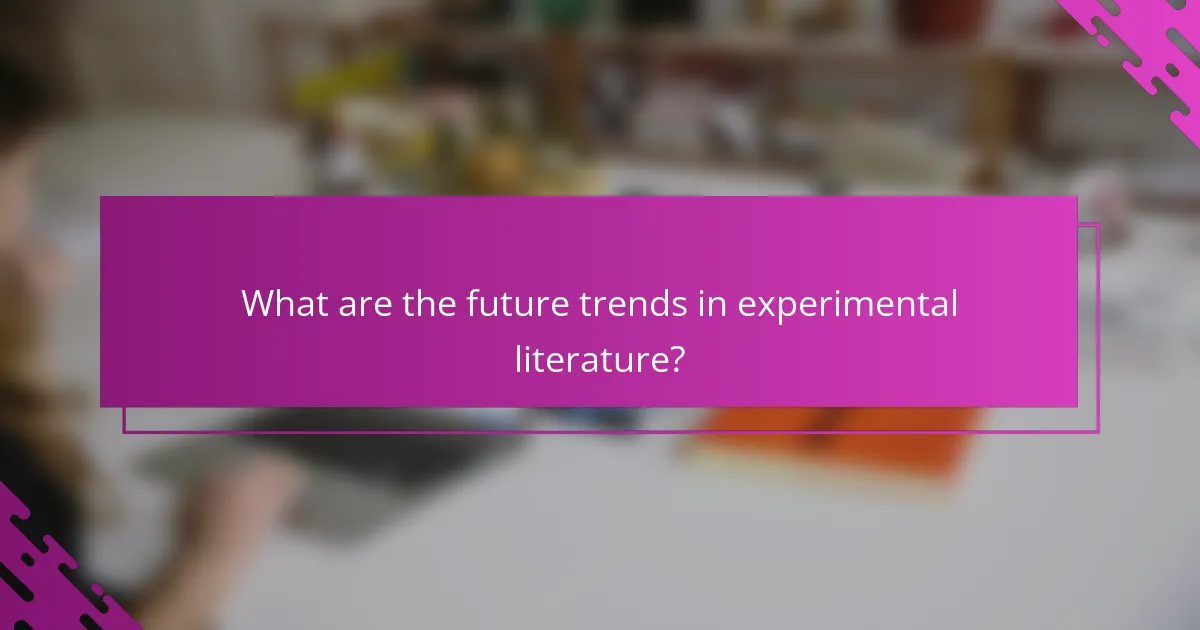
What are the future trends in experimental literature?
Future trends in experimental literature include increased interactivity, blending of genres, and use of digital platforms. Authors are likely to explore augmented reality and multimedia elements, enhancing reader engagement. The integration of artificial intelligence for narrative development may also emerge, offering personalized reading experiences. Additionally, themes reflecting societal challenges and global issues are expected to gain prominence, pushing boundaries of traditional storytelling.
Which emerging technologies are influencing the creation of experimental literature?
Emerging technologies significantly influence experimental literature by enabling new forms of storytelling. Digital platforms, interactive media, and artificial intelligence are reshaping narrative structures and reader engagement.
Digital platforms allow authors to publish in various formats, such as hypertext and multimedia, enhancing reader interaction. For instance, websites and apps can incorporate visuals, audio, and user-generated content, creating immersive experiences.
Interactive media fosters participatory storytelling, where readers can influence plot directions. This approach blurs the lines between authors and readers, inviting collaboration and co-creation in narratives.
Artificial intelligence offers tools for generating content and analyzing reader preferences. AI can assist in creating personalized narratives, adapting stories based on user input, and exploring unconventional narrative techniques.
These technologies collectively redefine the boundaries of literature, encouraging innovation and experimentation in storytelling.
How are new platforms changing the way experimental literature is consumed?
New platforms are transforming experimental literature consumption by enhancing accessibility and interactivity. Digital formats allow readers to engage with texts through multimedia elements, fostering a more immersive experience.
Platforms like interactive e-books and apps enable nonlinear storytelling, inviting readers to explore narratives in personalized ways. This shift encourages diverse interpretations and deeper connections with the material.
Additionally, social media facilitates community discussions around experimental works, expanding audience reach and promoting collaborative storytelling. The democratization of publishing through online platforms empowers emerging voices, enriching the landscape of experimental literature.
As a result, these changes not only redefine how stories are told but also expand the potential for reader engagement and interpretation, making experimental literature more relevant in contemporary culture.
What best practices can authors follow when exploring experimental literature?
Authors exploring experimental literature should embrace creativity, challenge conventions, and engage with diverse narratives. They can follow these best practices:
1. Embrace Nonlinear Structures: Experiment with fragmented timelines and multiple perspectives to enhance reader engagement.
2. Incorporate Varied Media: Use visual elements, typography, and multimedia to create a rich, immersive experience.
3. Focus on Language Play: Manipulate language through unconventional syntax, wordplay, and invented terms to provoke thought and evoke emotions.
4. Encourage Reader Interaction: Design narratives that invite readers to participate, interpret, or even influence the story’s direction.
5. Reflect on Themes: Explore complex themes such as identity, reality, and perception to deepen the work’s impact.
6. Study Influential Works: Analyze key texts in experimental literature to understand techniques and innovations that can inspire new creations.
